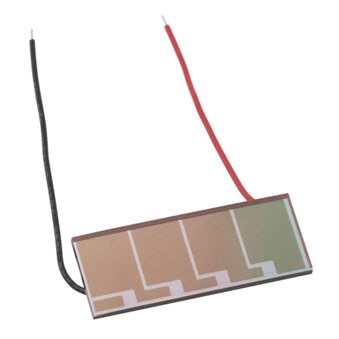How Can Solar Cells Improve Reliability for Indoor IoT Devices?
Many indoor IoT devices, from smart building sensors to asset trackers, still rely on disposable batteries because they’re simple to design. However, this reliance introduces several challenges, including a finite lifespan, maintenance overhead, operational downtime, and environmental concerns. Together, these factors directly impact the reliability of IoT devices.
The frequent replacement of batteries is furthermore time-consuming and inefficient. This is counterproductive to the IoT vision of autonomous, always-on devices. Therefore, a new approach to powering indoor IoT nodes is necessary to enhance reliability, minimize maintenance costs, and facilitate large-scale deployment.
According to a report by Transforma Insights, the growth of IoT devices is expected to increase energy demands 34 terawatt-hours by 2030. It is therefore crucial to use indoor solar cells for a continuous power supply, reduce electronic waste by using sustainable materials and avoiding batteries, and minimize the energy cost of computation and data transfer.
Recent years have witnessed massive technological advancements in the materials and architecture of photovoltaic technologies tailored for indoor environments. Crystalline silicon, a standard active material for outdoor solar panels, has a bandgap of 1.12 eV. However, given that the typical indoor light sources emit only in the visible range, the optimum bandgap shifts to 1.9 to 2.0 eV.
As a result, crystalline silicon performs poorly under indoor lighting conditions. To address this, the industry has developed alternatives with light-harvesting technologies for indoor use, including amorphous silicon, dye-sensitized solar cells (DSSCs), perovskite solar cells, and organic photovoltaic cells.
 Figure 1: Panasonic Energy’s AM-1456CA-DGK-E amorphous solar cell with glass type substrate. (Image source: Panasonic Energy)
Figure 1: Panasonic Energy’s AM-1456CA-DGK-E amorphous solar cell with glass type substrate. (Image source: Panasonic Energy)
Key indoor photovoltaic technologies for IoT
1. Amorphous silicon (a-Si) cells
Amorphous silicon (a-Si) is a well-established thin-film solar technology with an optical bandgap of approximately 1.6 eV, which is closer to the optimal value for indoor lighting applications. It was the first technology incorporated into low-power indoor IoT devices.
Due to its spectral match and relatively high open-circuit voltage at low light levels, a-Si outperforms crystalline silicon under typical room illumination. Tests show hydrogenated a-Si solar cells can achieve up to 21% efficiency under LED indoor lighting.
A key advantage of a-Si-based solar cells is their cost-effective thin-film manufacturing using gaseous plasma sources. This enables the solar cells to be manufactured on low-cost flexible substrates.
However, a significant limitation of this technology is that it requires a larger cell area to generate the same power as newer technologies. Additionally, each a-Si cell individually produces a relatively low voltage, so cells are often wired in series to reach the required voltage for IoT devices.
 Figure 2: TDK Corporation’s BCS4430B6 amorphous thin and flexible solar cell with 4.2 V open circuit voltage. (Image source: TDK Corporation)
Figure 2: TDK Corporation’s BCS4430B6 amorphous thin and flexible solar cell with 4.2 V open circuit voltage. (Image source: TDK Corporation)
2. Dye-sensitized solar cells (DSSC)
As a newer generation of photovoltaic devices, DSSCs operate similarly to photosynthesis with photosensitization of dye on the working electrode that generates electrons before being replenished by an electrolyte through a redox reaction. The dye can be optimized to match the emission spectrum of indoor light sources, making it a good match for indoor IoT applications.
A different approach to designing this is through multidimensional nanoarchitectures, such as composite photoanodes that combine scattering features to enhance light trapping and charge collection. One research paper claims 24% power conversion efficiency under extremely low artificial light of 0.014 mW/cm2 using a novel nanostructure.
3. Perovskite solar cells (PSCs)
Another promising alternative for indoor applications is PSCs, which were first researched in 2015. In this study, researchers controlled traps in the perovskite active layer and carrier dynamics by designing an electron transfer layer. The resulting PSC achieved a power conversion efficiency of 27.4% under indoor environments.
Perovskites are a family of solution-processable semiconductor materials that can be tuned to have ideal band gaps of 1.8 eV and high photovoltage, making them highly efficient under LED and fluorescent lighting. Perovskite indoor photovoltaic (IPV) devices have achieved record-breaking efficiencies. A 2025 study reported a 42% power conversion efficiency at 1,000 lux, which is among the highest ever recorded.
4. Organic photovoltaic (OPV) cells
Organic photovoltaics (OPVs) utilize carbon-based molecules as semiconductors to absorb light and generate power. By molecular design, organic semiconductors can be tailored to strongly target the visible spectrum. Optimized indoor OPVs have demonstrated power conversion efficiency approaching 30% under low illumination, which is comparable to the best DSSC or perovskite cells.
These characteristics make OPV particularly suitable for discrete IoT deployments in irregular form factors, as it can be printed as a thin, flexible film on substrates like PET plastic. Companies have even produced flexible indoor solar foils that can bend or conform to various shapes. For IoT designers, this means that a solar cell can be easily integrated, for instance, as a thin film on the surface of a sensor or a sticker-like power film inside a device.
Conclusion
Indoor solar cells have emerged as a key enabling technology for building autonomous IoT systems. By harvesting energy from ambient light, these solar cells provide a practical alternative to disposable batteries, enabling long-lasting and low-maintenance operation.
The ongoing advances in material science, particularly with perovskites and organics, are pushing power conversion efficiency levels higher under low-light conditions, while smart integration strategies are addressing stability and form factor constraints. The result is a clear path toward a more sustainable future for the IoT environment.

Have questions or comments? Continue the conversation on TechForum, DigiKey's online community and technical resource.
Visit TechForum








